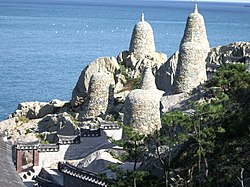| Gijang 기장군 | |
|---|---|
| County | |
| Korean transcription(s) | |
| • Hanja | 機張郡 |
| • Revised Romanization | Gijang-gun |
| • McCune-Reischauer | Kijang-gun |
 Haedong Yonggung Temple Haedong Yonggung Temple | |
 Flag Flag | |
 | |
| Country | South Korea |
| Region | Yeongnam |
| Provincial level | Busan |
| Administrative divisions | 3 eup, 2 myeon |
| Area | |
| • Total | 217.9 km (84.1 sq mi) |
| Population | |
| • Total | 176,388 |
| • Density | 810/km (2,100/sq mi) |
| • Dialect | Gyeongsang |
| Website | www |
Gijang County is a gun, or county, located between Haeundae-gu and Ulsan in northern Busan, South Korea.
History
Gijang first appears under its current name in the annals of the year 757, during the Unified Silla period. At that time it was made the hyeon of Gijang, part of Dongnae-gun. The Samguk Sagi records that it was known as Gaphwayanggok (甲火良谷) previously.
Historical landmarks in the county include the Buddhist temple of Jangansa, said to have been first built by Wonhyo in the 7th century.
Geography and demographics
Gijang is the most rural of Busan's districts, and consists mostly of vacant and agricultural land. Approximately 156.7 of its 217.9 square kilometers are empty and forested, mostly hilly land. The county's population has risen steadily since 1990, when it stood at 56,847. There is a fishing village set along the coastline.
Economy
Due to its location along the coast of the East Sea, Gijang is known as a center for the production of various kinds of seafood. These include anchovies and brown seaweed (miyeok).



Education
| This section needs expansion. You can help by adding to it. (August 2017) |
Gijang is also the current residence of the new Busan International Foreign School, which the Ministry of Education recently spent 46.9 billion won.
One elementary school, Daebyun Elementary School, was nicknamed the "poop school" since "Daebyun" meant feces. Its name originated from the village Daebyun-ri, which derived from the Daedonggobyunpo Port. The school opened in 1963, and in August 2017 it had 76 students. That month the school announced it was changing its name effective 2018.
Tourism
Other points of interest in the Gijang area include Toam Pottery Park and Ilgwang Beach, as well as the cliffside Haedong Yonggungsa temple. The fishing village is popular for its fresh seafood and sashimi.
It contains Orangdae Park.
Daejeon Port
Daejeon Port, located 4.1 km north of Haedong Yonggungsa Temple, accounts for 60% of the national anchovy catches and is called an anchovy port.
Around April, when the anchovy season comes, the sight of fishermen armed with raincoats, hats, boots, and rubber gloves opening their nets in a certain rhythm is truly spectacular. At the entrance of Daejeon Port, you can see Daejeon Port at a glance, enter the port, and slowly turn around Daejeon Port. There is a Suhyup building at the end and a small coastal road leads to the end of the road.
Administrative divisions

Gijang is divided into five parts:
- eup (larger towns):
- myeon (rural townships):
See also
References
- "Gijang-gun Statistical Yearbook 2005 (online version)". Archived from the original on February 9, 2006. Retrieved 2006-08-13.
- "Population statistics". Korea Ministry of the Interior and Safety. 2024.
- Chyung, Eun-ju (2017-08-17). "'Feces Elementary School' to change name after 55 years". The Korea Times. Retrieved 2017-08-18.
- "오랑대 공원(五郞臺公園) - 부산역사문화대전". Encyclopedia of Korean Local Culture. Retrieved 2024-08-09.
- 김, 동주 (2022-10-12). "[오시리아, 알아두면 즐거운 곳] 브릭·스케이트보드로 놀고 바다 뷰 힐링 즐기고". Busan Ilbo (in Korean). Retrieved 2024-08-09.
External links
| Districts of Busan | |
|---|---|
| Districts | |
| County | |
35°15′00″N 129°13′18″E / 35.25000°N 129.22167°E / 35.25000; 129.22167
Categories: